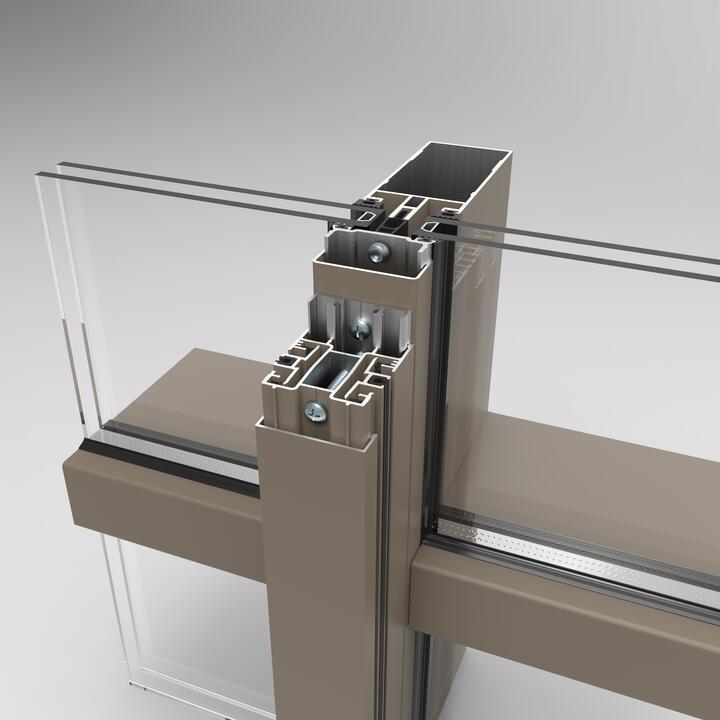The idea of transparency and openness has completely changed how buildings are created in the field of modern architecture. A crucial element that personifies this philosophy is the curtain walling system. Curtain walling systems, a flexible and intelligent architectural solution, have revolutionised the urban environment by providing unmatched environmental performance, structural integrity, and aesthetic appeal. In this piece, we explore the advancements and advantages of curtain walling systems and explain how they will influence architecture in the future.
Understanding Systems for Curtain Walls
A curtain walling system is a non-structural outer covering of a building that is composed primarily of glass panels held in place by an aluminum or steel frame. Curtain walls, in contrast to conventional load-bearing walls, are made to endure environmental factors like wind, seismic activity, and temperature swings without carrying any structural weight. By using this cutting-edge building technique, architects may design large facades with unbroken vistas that flood interior areas with natural light and obfuscate the distinction between indoor and outdoor surroundings.
Flexibility in Design
The design adaptability of curtain walling systems is one of its main benefits. These methods give architects the unmatched flexibility to experiment with different layouts, forms, and finishes, allowing them to design ground-breaking buildings and famous landmarks. The aesthetic and practical requirements of any project can be tailored using curtain walls, whether it's a modern residential structure, a futuristic office complex or a sleek skyscraper. The design options are almost endless, enabling architects to explore their imagination and push the limits of architectural innovation. Examples of these possibilities include curved glass panels and elaborate mullion patterns.
Improved Efficiency in Energy Use
In an era of increasing emphasis on sustainability and energy efficiency, curtain walling systems play a crucial role in minimizing the environmental footprint of buildings. Advanced glazing technologies, such as double or triple glazing, low-emissivity coatings, and insulated spacers, help optimize thermal performance and reduce heat loss, thus lowering the building's energy consumption and carbon emissions. Additionally, integrated shading devices and solar control films mitigate solar heat gain, enhancing occupant comfort and reducing the reliance on mechanical cooling systems. By incorporating these energy-saving features, curtain walling systems contribute to the creation of environmentally responsible and resource-efficient buildings.
Improved Efficiency in Energy Use
Despite their lightweight and transparent appearance, curtain walling systems are engineered to meet stringent structural standards and safety requirements. The aluminum or steel frames provide robust support and stability, ensuring the structural integrity of the building even in adverse conditions. Moreover, modern curtain walling systems are subjected to rigorous testing and quality control measures to verify their resistance to wind pressure, water infiltration, seismic forces, and fire hazards. This emphasis on structural reliability and safety instills confidence in building occupants and stakeholders, assuring them of the building's resilience and longevity.
Lighting and Eye Comfort
Daylighting, the practice of maximizing natural light in interior spaces, is a fundamental aspect of modern building design that enhances occupant well-being and productivity. Curtain walling systems excel in facilitating daylight penetration deep into the building's core, creating bright and inviting spaces that promote a sense of connectivity with the outdoors. The transparency of glass panels allows occupants to enjoy panoramic views of the surrounding environment while maintaining visual contact with the exterior world. Furthermore, the abundance of natural light reduces the need for artificial lighting during daylight hours, thereby reducing energy consumption and creating a more sustainable built environment.
Sound Performance
Acoustic comfort is critical for occupant pleasure and productivity in urban settings with noise pollution and traffic congestion. Systems for curtain walls can be designed to offer superior acoustic insulation, insulating interior areas from outside noise disruptions and fostering a calm atmosphere that is good for focus and relaxation. Curtain walls successfully reduce sound transmission while maintaining visual transparency and aesthetic appeal by combining laminated glass panels, acoustic seals, and sound-absorbing materials.
Conclusion
To sum up, curtain walling systems offer a seamless fusion of structural integrity, environmental performance, and elegant aesthetics, making them the height of innovation and sophistication in contemporary design. Curtain walls have pushed the envelope of architectural possibilities with their adaptability in form, improved energy efficiency, and added safety features. This has allowed architects to create distinctive structures that evoke wonder and capture the imagination. Curtain walling systems will surely continue to lead architectural progress, reshaping city skylines and altering our perception of the built environment as long as we uphold the values of transparency, sustainability, and innovation.


